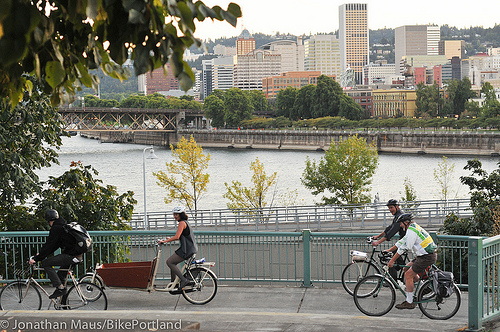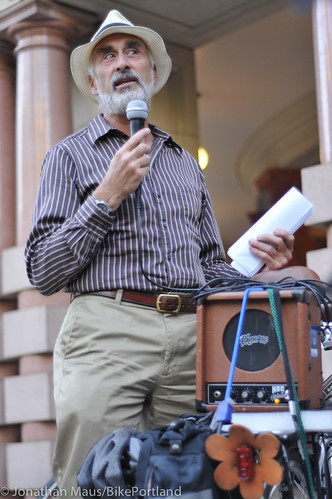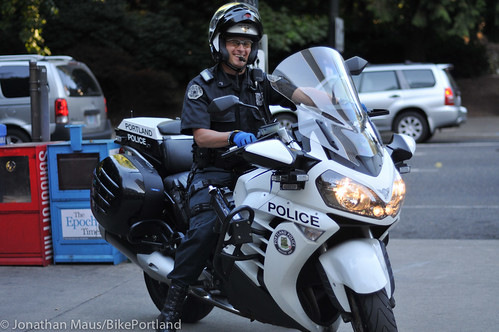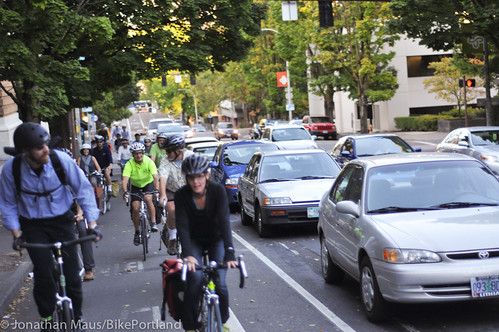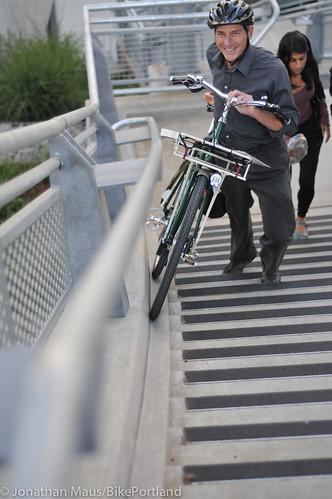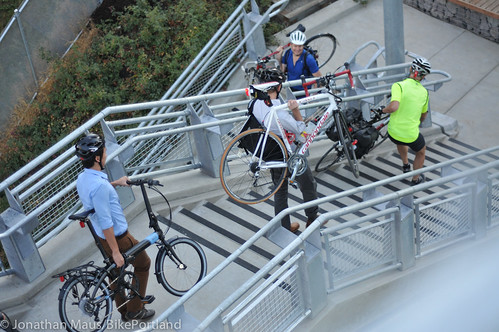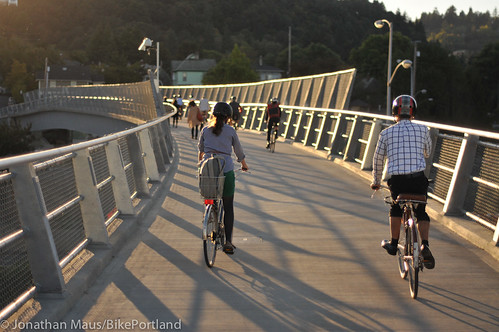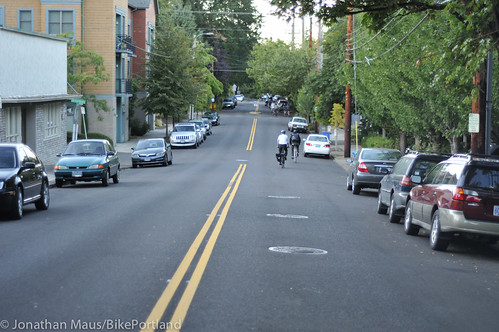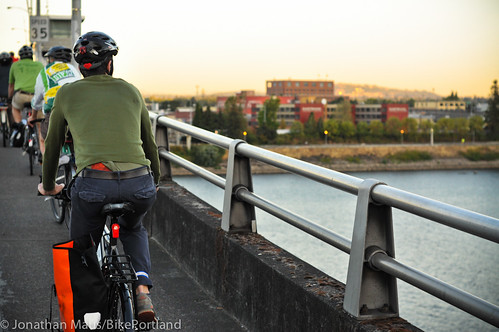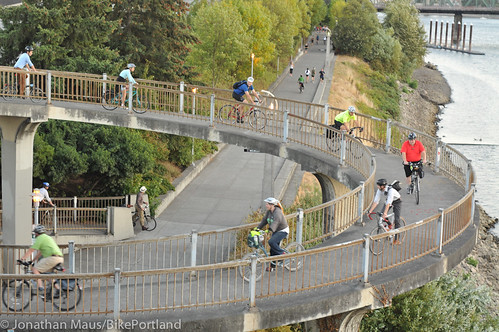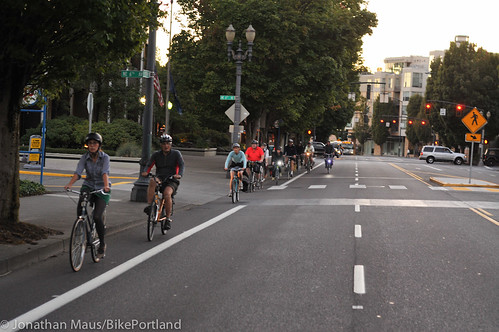
(Photo © J. Maus/BikePortland)
Last night was the annual Portland Bicycle Advisory Committee (BAC) facilities tour. The BAC is a volunteer group of citizens who advise PBOT on how transportation policies and projects impact bicycling. Each year, they leave their usual City Hall meeting room to get an up-close look at bike infrastructure. Last year we explored east Portland, and this year the focus was on downtown and the inner eastside — a part of town the city commonly refers to as the central city.
PBOT Bike Coordinator Roger Geller led the ride, and would speak from a mic attached to a small amp he carried on his rear rack. “I never thought we had enough to show off in the central city,” Geller said at the outset, “But we’ve done a lot of work.”
The route (annotated PDF here) took us from City Hall, up to Portland State University, over to the South Waterfront, back north to the Morrison Bridge, along the Esplanade up to the Lloyd District and back through northwest Portland via the Broadway Bridge. We stopped several times along the way to chat about the different bikeways and issues that came up.
Here’s Roger on the mic…
And we even had Portland Police Traffic Division Officer Ty Engstrom follow on his motorcycle! (He would have his bicycle; but he forgot this month’s meeting was a ride)…
The parking protected bike lane on SW Broadway…
New striping was recently added to allow transit vehicles direct access to the curb…
As we made our way up to the parking-protected bike lane on SW Broadway, Geller explained that there are currently only 2.9 miles of cycle-tracks (a general PBOT term for protected bike lanes) in Portland’s entire bikeway network. In his mind, “Everything else [in the network] should really be updated to provide more positive protection.”
A few minutes later we were rolling on the (relatively) new cycle-track on SW Moody. “If we had a network these,” Geller said, “We’d have 50% ridership in the central city.”
Our fun riding ended at the base of the new Gibbs Street Bridge, as some folks waited for the elevator, while others hoofed their bikes up several flights of stairs.
The new bridge connects the Lair Hill neighborhood to South Waterfront; but the access on the eastern side isn’t ideal. The elevator was recently out-of-order for a few weeks and the wheel gutter on the stairs is sort of a joke. It’s just a few inches wide and it’s difficult for many people to align their wheels on it while pushing up the steep incline. A PBOT staffer on the ride told me they’re considering improving the wheel gutter design, but the project hasn’t been green-lighted yet.
Once you’re up, it’s sublime to roll over the noise and traffic of I-5…
Once over the bridge, we connected to SW Corbett Ave. With the new bridge, folks in the Lair Hill neighborhood are excited to be connected to the south waterfront. Advocate and resident Roger Averbeck said Corbett is a key connection and now all that’s left is to “connect the dots” between it and other projects in the area. Averbeck would like to see Corbett get the bike boulevard treatment with speed bumps and sharrows. As you can see below, it’s got a lot of potential…
On our way back north through Waterfront Park and onto the Morrison Bridge, I asked Geller about the potential for a new bike path that would alleviate crowding on the existing shared facility on the riverfront and would be more pleasant and safer than the bike lanes on Naito Parkway. He didn’t say anything was in the works, but he did mention that the park’s Master Plan (adopted in 2002) calls for a bike path through the middle of the grass (I’ll look into that and post separately).
Before we climbed up onto the Morrison Bridge, the front of the group was nearly taken out by a woman driving a car. She must have been distracted because she plowed right through a red light. She locked up her car’s brakes and skid for several feet, narrowly missing a few of the riders. Whew!
Up onto the Morrison Bridge, we stopped for a while to enjoy the setting sun and then descended to the Esplanade via that neat corkscrew that I always enjoy riding on.
From the Esplanade we rode northeast up to the Lloyd District via NE Multnomah Street, which is slated for a road diet. PBOT plans to change the cross-section from five standard lanes and narrow bike lanes to just three standard lanes and protected bike lanes. That’s a very exciting project that I can’t wait to report on (stay tuned).
Here’s how the street looks today (lots of room to work with)…
We then headed west on Broadway (cheering as we passed the partially closed Wheeler Ave) and into the Pearl District via NW Lovejoy. Noticing the sorry state of the two measly plastic bollards that remain (after PBOT’s failed attempts to keep cars out of the bike lane due to the “track-straddling” phenomenon); I heard a PBOT staffer say that, “Motorists would rather run over plastic cones than drive in the streetcar tracks.”
The good news is that I hear PBOT is still discussing how to make bollards work in this location. Stay tuned.
The other big issue with Lovejoy — after it was decommissioned for the streetcar project — is that now bike traffic is forced over to NW Marshall. PBOT intended to make Marshall a bike boulevard, but it hasn’t worked out that way. “The auto traffic volumes on Marshall are high, and there are a lot of stop signs,” Geller admitted. To help improve it, they plan to but a traffic diverter at NW 10th (and maybe another one at 15th if that doesn’t work), and turning some stop signs is another possibility.
After a brief stop to pay our respects to the Zoobomb Pyle sculpture on SW Stark (and get a nice history lesson about it from BTA staffer Carl Larson), we rolled down the buffered bike lane on SW Stark. Geller gave us an update on PBOT’s efforts to keep cars from illegally driving on them. He said they’ve got a new design, “to combat confusion” (I’ll post it separately). He also added that PBOT has done a bike count on the Stark and Oak buffered lanes for the first time: 900 daily bike trips on Oak and 1,300 on Stark. Given the existing motor vehicle trips on each street, Geller estimated businesses on Stark and Oak are seeing 25% more potential customers since before the lanes were put in. “That’s the kind of story — that bikes mean business — that we need to tell,” he said.
The night ended at a pub with beer and conversation that went late into the night. I felt a sense a sense of urgency from several people that the time has come for Portland to move the needle and create more — and better — separated bikeways throughout the city. The question is, how do we get unstuck and actually make it happen?
I have some ideas on that. Stay tuned.
